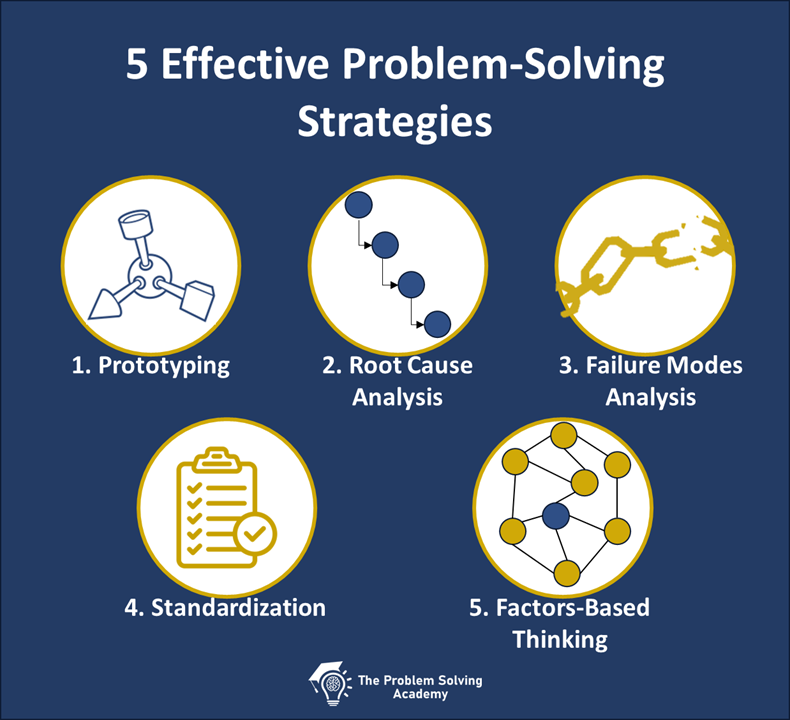Top 5 Problem-Solving Strategies
We all face problems every day. Some are simple like what to do or what to wear, while others are complex. Like making business decisions with a budget, a timeline, and a variety of stakeholders.
No matter what problem you’re facing, arming yourself with these five problem-solving strategies can help you become an effective and productive problem solver and arrive at a good solution.
What are problem solving strategies?
If you’ve ever made a difficult decision, you know the difficulty in not just choosing amongst options, but structuring your thinking into cogent thought just to think through the possible consequence and considerations of those actions. By familiarizing yourself with these strategies, you will be better equipped to navigate difficult decisions and will successfully find solutions.
In general, effective problem-solving strategies include the following steps:
Clarifying the problem
Understanding the problem.
Determining solutions.
Implement the solution.
Monitoring the impact of the solution.
The key for decision-makers and problem solvers is to find the problem-solving approaches that work best for you and your needs. One strategy may work well in an organization but doesn’t fit the culture of another. Personality differences will change your comfort with these strategies as well.
It’s important to be equipped with several problem-solving strategies so you use the one that’s most effective for your current situation.
1. Low-Resolution Prototyping
Sometimes, tackling a problem and arriving at a solution head-on might feel overwhelming. Low-resolution prototyping involves creating simplified versions of solutions to test their viability. Architects always build small models before constructing skyscrapers. It allows you to spot flaws early, saving time and resources. Whether designing a website or solving a math puzzle, starting with a basic prototype helps refine your approach, making the final solution more robust.
2. Root Cause Analysis
When faced with a problem, it's crucial to dig deeper and understand its origin. Root Cause Analysis (RCA) is like peeling an onion, revealing layers until you reach the core issue. By identifying the fundamental cause, rather than just addressing symptoms, you prevent recurring problems. Think about getting a sick with a bad infection, it’s not enough to grab the tissues and drink chicken noodle soup. Instead, you want to fight the cause of the sickness with antibiotics. The same principle applies to every problem we face.
3. Failure Modes Analysis
In the journey of problem-solving, failures aren't roadblocks; they're stepping stones. Failure Modes Analysis (FMA) involves studying potential mishaps in a system to prevent them. Think of it as foreseeing potholes in the road before driving. By understanding how things can go wrong, you design better strategies for success. Whether it's a manufacturing process or a group project, FMA helps anticipate pitfalls, making your path to success smoother.
4. Standardization
Imagine assembling a piece of furniture without standardized instructions – chaos! Standardization involves creating uniform processes, making it easier to solve problems systematically. From baking a cake to managing a project, having standardized steps ensures consistency. It minimizes errors and streamlines workflows. By setting a standard, you create a reliable blueprint for problem-solving, reducing ambiguity and increasing efficiency.
5. Factors-Based Thinking
Problems are seldom isolated; they're interconnected puzzles waiting to be solved. Factors-based thinking involves seeing the bigger picture, understanding how different elements relate. It's like connecting the dots in a painting – each dot matters, but the masterpiece emerges from the whole. Whether dealing with environmental issues or social challenges, factors-based thinking helps you navigate complexities by considering the ripple effects of your decisions. It's about understanding the journey, not just the destination.
Conclusion
In the realm of problem-solving, having a diverse set of tools is key. Root Cause Analysis helps you get to the heart of the matter, Low-Resolution Prototyping tests solutions in a manageable way, Failure Modes Analysis prepares you for potential hurdles, Standardization brings consistency, and Process Thinking connects the dots. Just like a skilled craftsman relies on various tools for different tasks, being a proficient problem solver involves utilizing these strategies judiciously. So, whether you're fixing a broken toy or addressing complex global issues, remember: a well-equipped problem solver is never short of solutions.

